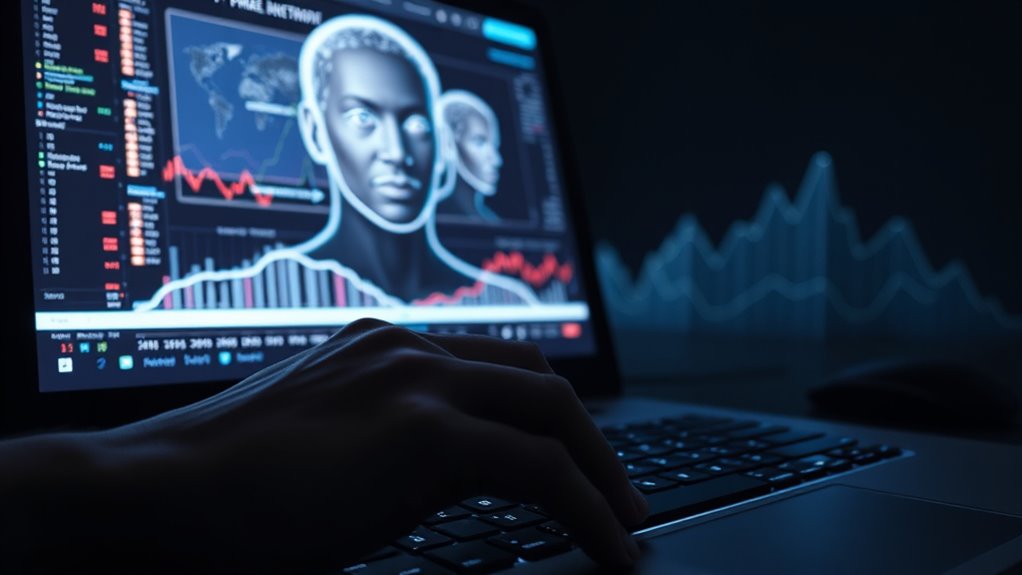AI-generated personas now easily breach KYC barriers by creating convincing synthetic identities that seem legitimate. These identities combine real and fabricated data, fooling verification systems using advanced AI algorithms. Criminals use deepfake images and synthetic biometric data to bypass biometric checks, making detection challenging. As fraudsters continuously refine their tactics, organizations must stay ahead with smarter detection methods. Keep exploring how these sophisticated techniques work and how to protect against them.
Key Takeaways
- AI-generated synthetic personas can mimic authentic data, bypassing traditional KYC verification methods.
- Deepfake images and stolen biometric templates enable synthetic identities to deceive biometric authentication systems.
- Advanced AI tools produce realistic documents and behavioral patterns that challenge existing fraud detection algorithms.
- Continuous AI-driven evolution of synthetic identities makes detection increasingly complex for financial institutions.
- Integrating behavioral analytics and machine learning enhances the ability to identify and prevent AI-generated synthetic identity breaches.

Have you ever wondered how criminals create fake identities that are hard to detect? It’s a clever mix of technology and deception that allows them to bypass traditional security measures, especially in the world of financial services and online platforms. One of the key tools they exploit is synthetic identity creation, where they combine real and fabricated information to forge identities that appear legitimate. These artificially generated personas are crafted using advanced AI algorithms, which simulate authentic data patterns, making them increasingly difficult for conventional verification methods to catch.
Criminals use AI-crafted synthetic identities to bypass security and evade detection in financial and online platforms.
To pull this off, fraudsters often leverage biometric authentication systems designed to verify identities based on physical traits like fingerprints, facial recognition, or voice. Ironically, these systems are not infallible, especially when manipulated with sophisticated synthetic identities that mimic real biometric data. Criminals may use deepfake images or stolen biometric templates to fool biometric authentication, allowing them to access accounts or open new ones under false pretenses. Because biometric data is considered highly secure, fraud detection algorithms now focus heavily on analyzing subtle inconsistencies or anomalies in biometric inputs, but these algorithms can still be outmaneuvered by well-crafted synthetic data.
The process begins with the creation of a synthetic identity that includes a combination of legitimate and fabricated details—such as a real Social Security number paired with a fictitious name and address. Criminals often run these fake identities through fraud detection algorithms designed to flag suspicious activity, but they continuously adapt their tactics to evade detection. For instance, they might use AI to generate realistic-looking documents or to simulate behavioral patterns that seem natural. These algorithms analyze numerous data points—transaction histories, device fingerprints, and biometric inputs—to identify inconsistencies. Yet, as AI becomes more sophisticated, so do the fake personas, making it a cat-and-mouse game where fraudsters constantly refine their synthetic identities to slip past defenses. Additionally, the use of high-quality AI-generated data further complicates detection efforts, pushing organizations to seek more advanced solutions.
The challenge for organizations is to stay ahead of these evolving tactics. While biometric authentication and fraud detection algorithms are crucial tools, they need continuous improvement and integration with behavioral analytics and machine learning. By doing so, you can better identify anomalies that suggest synthetic identities are being used, even when they mimic real data convincingly. Ultimately, understanding how these fake identities are created and exploiting weaknesses in current verification systems helps you develop more robust defenses against synthetic identity fraud. Staying vigilant and investing in advanced AI-driven solutions can help you better protect your systems from these increasingly sophisticated threats.
Frequently Asked Questions
How Do Ai-Generated Personas Evade Traditional KYC Checks?
You might wonder how AI-generated personas bypass traditional KYC checks. These personas often mimic real data, making biometric authentication less effective. They use sophisticated techniques to create convincing identities, fooling automated systems. To combat this, you should enhance customer education on security practices and incorporate advanced verification methods, like biometric authentication, to better detect fake identities and protect against fraudulent activities.
What Are the Signs of Synthetic Identity Fraud in Transactions?
Imagine catching a shadow slipping through the cracks of your fortress. Signs of synthetic identity fraud appear in suspicious transaction patterns, inconsistent identity verification details, or sudden spikes in activity. You must sharpen your transaction monitoring and scrutinize anomalies, like a vigilant guard. These clues help you spot fake personas before they breach your defenses, ensuring your system stays secure and trustworthy.
Can Existing AI Detection Tools Identify All Synthetic Identities?
You might wonder if existing AI detection tools can spot all synthetic identities. While they use biometric verification and behavioral analytics to identify suspicious activity, no tool is foolproof. Sophisticated AI-generated personas can still slip through, especially if they mimic real behavior convincingly. Continually updating these tools and combining multiple methods improves detection, but some synthetic identities may still evade detection entirely.
How Do Fraudsters Create Convincing Ai-Generated Identities?
Did you know that over 60% of fraudsters use AI to craft convincing fake identities? They create these by combining real data with synthetic details, making biometric verification less reliable. Fraudsters also exploit social engineering to gather personal info, then generate AI personas that seem authentic. This combination helps them bypass KYC barriers, making it harder for detection tools to identify these convincing, AI-generated identities.
What Future Technologies Might Combat Synthetic Identity Fraud?
You might see future technologies like biometric verification and blockchain authentication become key tools in combating synthetic identity fraud. Biometric scans, like fingerprint or facial recognition, can verify real individuals, making it harder for fraudsters to use fake identities. Blockchain offers a secure, transparent way to authenticate identities and transactions, reducing the risk of synthetic personas. Together, these innovations could strengthen KYC processes and protect against evolving fraud tactics.
Conclusion
As AI-generated personas slip through KYC barriers like shadows in the night, you’re reminded that the fight against synthetic identity fraud is an ongoing battle. These digital chameleons threaten to erode trust and turn your security measures into castles built on sand. But by staying vigilant and evolving with technology, you can light the way through this dark maze, protecting what’s real and precious in a world increasingly blurred by deception.









